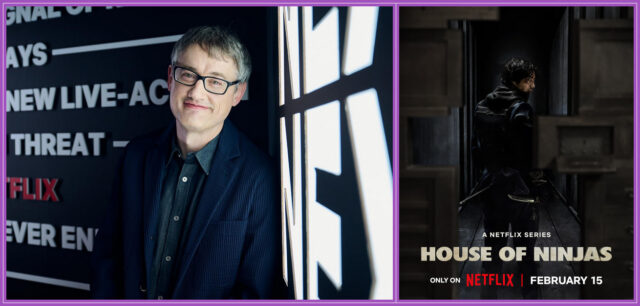
Writer and Director DAVE BOYLE goes in-depth in this exclusive interview discussing the making of the smash Netflix series HOUSE OF NINJAS.
It has been a privilege and a pleasure to have known writer/director since his first film some 18 years ago, Big Dreams, Little Tokyo. He was, and is, a filmmaker who brings a fresh voice and eye to the table and does so with thought and care in not only the writing and story structure, but character development, and his solid technical directorial prowess. From Day One, I knew Dave was someone to keep an eye on.
Seamlessly melding Asian old-world philosophies and customs with his own values and some fun “fish out of water” American experiences, Dave continually changes things up while staying true to his values and vision. (For a real “fish out of water” experience check out “Tokyo Cowboy” which Dave wrote but was unable to direct due to his being in Japan shooting HOUSE OF NINJAS.) Man From Reno was a big pivot point as Dave delivered a stunning neo-noir mystery with a maturity that took him into new storytelling territory to great acclaim. Then came television; first directing an episode “Dimension 404” and then, HOUSE OF NINJAS which is unquestionably DAVE BOYLE’s best work to date. And quite honestly, I don’t know how he will top it.
SYNOPSIS: Ninjas existed throughout many pivotal times in Japanese history — but what if they were still secretly undertaking missions in modern society? Set in today’s Japan, this series tells the story of the Tawara family, the last ninja clan who abandoned their roots after a mission gone wrong. Now, an unprecedented crisis beckons the family back into action.
HOUSE OF NINJAS is directed by DAVE BOYLE, written by Dave Boyle, Masahiro Yamaura, Kota Oura, and Kanna Kimura, based on a story by Kento Kaku, Yoshiaki Murao, and Takafumi Imai, and boasts an award-worthy cast including Kento Kaku, Yosuke Eguchi, Tae Kimura, Kengo Kora, Aju Makita, Riho Yoshioka, Nobuko Miyamoto, Tomorowo Taguchi, Tokio Emoto, Pierre Taki, Kyusaku Shimada, Mariko Tsutsui, Tenta Banka.
With everything from large-scale action set pieces to intimate hand-to-hand combat and swordplay to the intimacy of a family dinner, HOUSE OF NINJAS is beautifully told cinematographically as well as tonally as we feel all of the emotional beats. It’s funny, playful, at times even whimsical, all of which comes through with terrific needle drops for each episode. Then there are the expected dynamics within the Tawara multi-generational family unit living under the same roof with a young son who wants to grow up way before his time, a daughter struggling with teen/20-something angst, a frustrated mother bored as a housewife and craving her former life as a ninja, a grandmother who has many secrets and then some, another son dealing with being “second fiddle” to an elder brother who died, a father who insists everything and everyone is “normal” and non-ninja, and so much more. And then there’s the intrigue and mystery of the ninja life and why the Tawaras may be getting pulled back into that world. There is something for everyone in HOUSE OF NINJAS, all of which is brought to life perfectly through characters and casting, lighting and lensing, action, pacing, and music.
As we have done for years, Dave and I again spoke at length in this exclusive interview, this time discussing all things HOUSE OF NINJA, and even some “Tokyo Cowboy”, among them:
- the development and writing process
- finding a unique angle for a modern ninja story through research and core values
- developing characters and casting each (including the scene-stealing young star Tenta Banka and the legendary Nobuko Miyamoto)
- a cat, an umbrella, and a kazoo appear on a television set
- shooting in Japan in Japanese
- designing the visual grammar and working with cinematographer Shoji Ehara
- developing visual grammar for a ninja series consistent with a dark and blue-black color palette, blending costumes with the environment for a disappearing effect
- filming the ordinary world by using locations that may seem ordinary at first but have a hidden, playful, and eerie quality
- finding the tone and playfulness of the show
- working with a cast and crew who were supportive of a non-native Japanese-speaking director and his style of filmmaking
- visual and tonal shifts between episodes; varying camera angles; ditching; lighting
- giving episodes different feels including a more psychological suspense tone in some episodes while while maintaining a cohesive synergy among all eight episodes
- the culminating Episode Eight with a myriad of practical effects, including fog, and the challenge of having to recreate for each take
- creating a black-and-white version of a key scene which was layered over the original color footage
- music and scoring of a TV series, highlighting the needle drops and collaboration with composer Jonathan Snipes
- tidbits on writing “Tokyo Cowboy” and why Dave had to step aside from directing because of shooting HOUSE OF NINJAS
- and more!
I’m ready for Season Two!
TAKE A LISTEN. . .
by debbie elias, exclusive interview February 19, 2024
HOUSE OF NINJAS is currently streaming on Netflix












